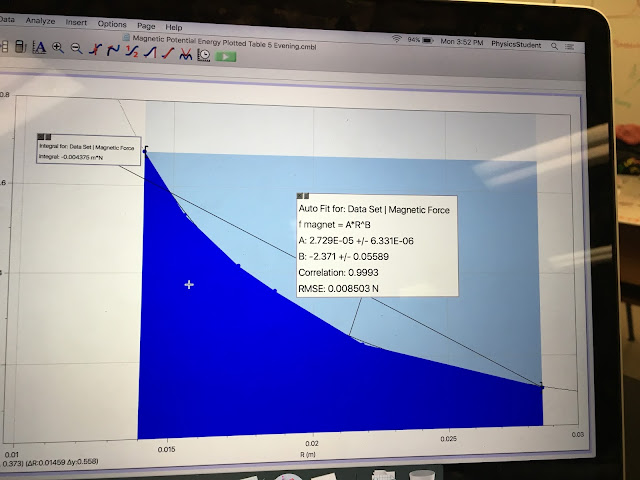Purpose: Determine whether or not momentum and total energy are conserved in a collision between two objects.
Theory:
During collision of an object, assuming no external forces, overall direction and magnitude of momentum is expected to be conserved. Kinetic energy is not expected to be conserved as the collision is non-elastic. These hypothesis can be tested by taking velocity measurements of the two objects prior to collision and after collision. Total momentum and kinetic energy can then be calculated according to the equations p = mv and Ek = 1/2 mv^2 and initial and final values can be compared.
Apparatus:
- Smooth glass panel
- Glass marble (2)
- Steel ball bearing
- Slow-motion video recording device
- Camera positioning rig
- Meter stick
Procedure:
Level the glass panel by adjusting the legs beneath the panel so that a ball remains stationary when placed. Position the video recording device in the rig set up above the glass panel so that most if not all of the glass panel is in frame. Position a meter stick on the glass panel within the video frame. Begin recording at at least 120 frames per second and collide the steel ball bearing with a stationary marble. Perform the experiment again by colliding two of the same type of marble. Perform video analysis using LoggerPro, skipping 2-4 frames for every data point to compensate for the increased FPS. Define an axis as parallel as possible to the initial motion of the moving ball prior to collision.
Data and Graphs:
Photo of experimental setup and the method used to produce data of position and velocity
Graphs of x and y velocities for a steel ball colliding with a marble
Graphs of x and y velocities for two marbles colliding
Table of x and y velocities, calculated change in momentum, and change in kinetic energy
| Mmarble | 5,2 | g | ||
| Msteel | 28 | g | ||
| Δp = m(vf-vi) | ||||
| Velocity (m/s) | ||||
| Experiment 1 | Steel | Marble | ||
| X1 | Y1 | X2 | Y2 | |
| Initial | 0,3190 | 0 | 0 | 0 |
| Final | 0,2817 | -0,0281 | 0,08207 | 0,1310 |
| Δp (kgm/s) | -0,00101 | 0,000804 | ||
| ΔKE (J) | -0,101 | 6,21E-05 | ||
| Experiment 2 | Marble 1 | Marble 2 | ||
| X1 | Y1 | X2 | Y2 | |
| Initial | 0,5181 | 0 | 0 | 0 |
| Final | 0,1499 | -0,1233 | 0,2804 | 0,09052 |
| Δp (kgm/s) | -0,00168 | 0,00153 | ||
| ΔKE (J) | -0,268 | 0,000226 |
Data Analysis:
Using position graphs produced by video analysis, x and y velocities for the two balls in each experiment were found by using LoggerPro's linear fit option for graphical analysis. The slope of each graph was taken to be its velocity in that direction of motion. The magnitude of each ball's initial and final velocity was then found and used to calculate change in momentum and change in kinetic energy.
Conclusion:
Momentum is not entirely conserved during the collision as the stationary object experienced a smaller change in momentum than did the initially moving object. In the first experiment, the second ball experienced a change in momentum of +0,00804kgm/s while the first ball experienced a change in momentum of -0,00101kgm/s, an approximately 21% difference. The second experiment produced more similar changes in momentum at -0,00168kgm/s for the first ball, giving a difference of approximately 9%. Kinetic energy was not conserved as expected with the first ball losing 0,101J of kinetic energy and the second ball gaining only 0,0000621J of kinetic energy.
























